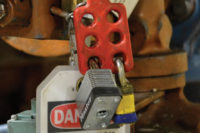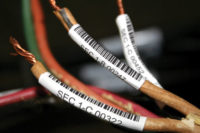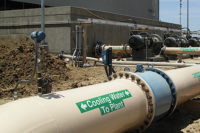But how can one create ideal lighting in the industrial workplace? Instead of unified, even lighting, employees typically labor under a mishmash of overhead fluorescent lights, natural lighting, computer monitors and other machinery. The answer is complex. It sort of depends on where and how the lighting is used and how light interplays with signs and labels throughout the workplace.
Learn about light
In the process of learning how to improve workplace lighting, it’s useful to understand terms such as lumen (a measurable unit of light flow), foot candle (the English unit of measurement of the light level on a surface), efficacy (a metric used to compare light output to energy consumption measured in lumens per watt), contrast (the relationship between the luminance of an object and its background) and glare (the effect of brightness or differences in brightness within the visual field which can be very annoying).
Another important term relating to the “feeling” of the light is color temperature — a specification of the color appearance of a light source, relating the color to a reference source heated to a particular temperature, measured by the thermal unit of Kelvin. The measurement can also be described as the “warmth” or “coolness” of a light source. Generally, sources below 3200K are considered “warm” while those about 4000K are considered “cool” sources (and appear slightly blue). This coloration impacts how much eyestrain one may experience. Reading small words or putting together tiny mechanical pieces requires different hues than, say, scanning around a warehouse to find the forklift.
Facility managers today face many challenges as the industrial sector transitions to the digital age. An aging workforce, worker productivity, product quality and technological advancements, such as miniaturization, all affect production.
Improvements in lighting systems are just one aspect of supporting the demands on manufacturing processes. Older lighting systems are not able to provide the quantity or quality of light required for the visual tasks in modern production facilities. At the same time, there is pressure to keep operating expenses in line by managing energy.
Energy savings
High energy costs and inadequate lighting in the warehouse are a challenge whether you have a 10,000- or 100,000-square-foot warehouse. Do you want to increase light capacity? Do you want to reduce monthly utility bills? A good way to start on the path toward energy savings is through an energy analysis.
“If a client spends $1 million on a lighting system that results in energy savings of $35,000 a month, those state-of-the-art lights will pay for themselves in just three years. To the CFO or accounts payable manager responsible for the monthly utility bill, that’s a substantial ROI,” said Jeff Fogle, Hy-Tek Material Handling’s Integrated Systems Division. “Rebates or incentives are usually from the client’s energy provider (local utility), and the tax deductions are federal deductions. Some states do offer special financing options for certain smaller or specialized companies.”
Twenty years ago the industry was designing work spaces with 50 foot candles or more — a mass of fluorescent fixtures, according to Andy Pease, In Balance Green Consulting. Those spaces were overlit, wasted energy and didn’t increase visual comfort. Today, strategies for efficiency include:
- Design ambient light levels to be low, around 10 foot candles, and have task lighting for specific work areas. To achieve 50 foot candles at a detailed task may only need 18 watts, for example, when the light is close to the task, but twice that wattage if the light is at the ceiling level. Warehouse ceiling heights vary from 18 to 24 feet high.
- Install diffuse skylights or suntubes to have even daylight throughout the space, so that the ambient light, on photosensors, is rarely needed.
- More high-efficiency lighting, such as LED.
Creating a new lighting environment
Dustin Smith, RLL Design, has done a great job breaking down the steps involved in creating new industrial lighting environments and retrofitting existing facilities.
1) Target lighting levels are determined and fixtures and lamp types are discussed. Budget plays a big role in fixture selection as lighting prices vary greatly.
2) Once these objectives are set, lighting calculation software helps determine light levels for given areas.
3) From there, placement adjustments are made, alternate fixtures might be selected, and the design process is wrapped up.
4) Finally, lighting fixtures are reviewed. Fixtures should be placed in a manner that yields the least amount of glare while optimizing the amount of light that they are able to produce.
Special situations
- At food manufacturing plants where contamination is a safety concern, cleanroom-style lighting fixtures are used because they’re rugged enough to handle being blasted by high pressure hoses used during chemical washdown procedures.
- Lighting for aircraft cockpits and cabins demands consideration for fire protection, energy consumption, heat generation and comfort through a variety of illuminants.
- As part of the redesign of a retail distribution center, Hy-Tek integrated lighting, life safety signs, and fire protection systems. They designed and installed egress, or emergency lighting to help ensure employee safety. The egress lighting system also incorporated motion sensors, battery back-ups, and LED exit signs. Striped and fluorescent floor marking tape is also commonly used to indicate areas that must be kept clear and to show emergency exit routes.
How does it feel?
Light definitely affects our mood. In the winter when I get to work at 6 a.m., it is pitch dark and the office is totally quiet. Things pick up when it’s lighter outside between 7:30–8:00 am. The vibe completely changes in the summer.
For many of us working in cavernous warehouses and distribution centers, moving goods in and out is a starkly different reality than staring at a computer for hours, but both environments require comfortable lighting for maximum work productivity and comfort.
“One of our most effective techniques to gauge satisfaction with lighting systems is to walk clients around with a light meter in their current work environment. Light levels are designed to a specific brightness, in foot candles, but the numbers don’t mean much until you can see how 10 foot candles or 50 foot candles feels. By asking what spaces they like and don’t like, we learn what light levels are preferred and also check on glare and contrast, which are factors in visual comfort,” said Pease.
Measuring the success of your industrial lighting environment is a balance of science, mathematics, ergonomics and economics. Doing the right thing will save big bucks, improve safety and elevate the mood, so what are you waiting for?







